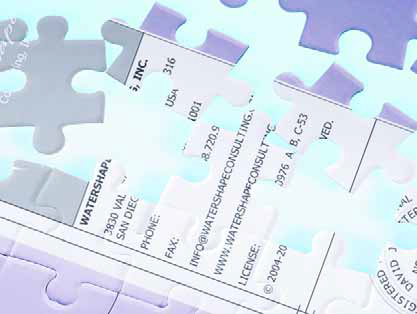communication
In my last “Currents” column (June 2009), I began a discussion of Project Manuals with an overview of these written specifications and other construction documents and how they are formally bound and made part of a project’s contract documents. This time, we’ll dig inside the manuals and take a closer look at what they contain. Let me start with a simple recommendation: If you don’t already work with Project Manuals in some form, now is probably a good time to get started – especially if you’re a watershaper who prepares designs to be
One of the themes I’ve covered repeatedly through the years has had to do with the need for all of us to become effective team players. True, there have been times when egos have gotten in the way and I’ve found myself in fairly dysfunctional groups, but for all that, I have to say that collaboration very often yields great results. In fact, the vast majority of team projects in which I get involved these days are wonderful collaborations among clients, architects and general contractors as well as (depending on the project) interior designers, landscape architects, lighting designers and more. Of all those practitioners,
Several years back, I was in a seminar at the International Pool & Spa Expo when the instructor asked everyone who had an e-mail address to raise a hand. Way back then - it was in the late 1980s or perhaps even the early '90s - using the Internet for communication was a brand-new concept to most people and there were only a few people in the room who lifted an arm. I wasn't one of them, and at that point I had no idea that e-mail and Web sites would ever become such an integral part of my life. At that time, in fact, I didn't think I'd ever need an e-mail address. After all, I
I think we can all agree that design communication between architects, engineers, designers and contractors should be clear and concise. If that’s the case, it follows that plans and other construction documents should be uniform in their organization and layout – in other words, that they should follow a set of standards to which everyone in the design/construction community can and will adhere. Why the bother? The plain fact is that any given project involves a cast of characters that will be different – sometimes completely so – from just about any other project. This is why I’m such a strong advocate for
Those of us in the design and construction industry are engaged in a singularly complicated human endeavor. To make things work, it’s common for many technical disciplines to come together, including soils and structural engineers and contractors and subcontractors as well as architects, interior designers, landscape architects, lighting designers and watershapers – all working in concert to bring form to the goals and aspirations of the clients. These professionals unite in designing spaces that people use and occupy – a simple yet profound thread that ties all of us engaged in any given project together. Through our combined efforts, we
In my November 2007 column, I discussed the power of friendship and how it can enhance our professional and personal lives. Along the way, I used examples from my own career and kept the focus on a personal level. This time around, however, I’ll be broadening the focus and expanding the concept to cover cultural and even global relationships. One of my key points in November was that by surrounding yourself with a circle of diverse, passionate, knowledgeable and thoughtful friends, you
The most important skill needed by any designer is the ability to communicate clearly. This skill takes many forms, from verbal descriptions, well-assembled photographs and material samples to graphical depictions of concepts, details, dimensioned layouts and other drawn elements. When a watershaper is pushing design limits, in fact, he or she is often called upon to use all of these communication tools to convey ideas and aspire to offer something unique. In recent years, computer-aided design (CAD) systems have become increasingly popular as a tool in preparing construction drawings. Combined with the designer's creativity, these programs assist greatly in the production of plans. Unfortunately, however, our usage of them varies greatly in style and content from project to project and designer to designer. Indeed, these variations can be so radical that some plans are not easily understood by other professionals; moreover, the exchange of electronic CAD files is not always as convenient or efficient as it should be. This is why a group of industry experts has banded together to create the National CAD Standard (NCS), which is the core subject of this brief series of articles. That effort, which has met
The most important skill needed by any designer is the ability to communicate clearly. This skill takes many forms, from verbal descriptions, well-assembled photographs and material samples to graphical depictions of concepts, details, dimensioned layouts and other drawn elements. When a watershaper is pushing design limits, in fact, he or she is often called upon to use all of these communication tools to convey ideas and aspire to offer something unique. In recent years, computer-aided design (CAD) systems have become increasingly popular as a tool in preparing construction drawings. Combined with the designer's creativity, these programs assist greatly in the production of plans. Unfortunately, however, our usage of them varies greatly in style and content from project to project and designer to designer. Indeed, these variations can be so radical that some plans are not easily understood by other professionals; moreover, the exchange of electronic CAD files is not always as convenient or efficient as it should be. This is why a group of industry experts has banded together to create the National CAD Standard (NCS), which is the core subject of this brief series of articles. That effort, which has met
For years now, the power of teamwork and the communication it requires have been recurring, primary themes in the pages of WaterShapes. It's no secret that, more than ever before, the design, engineering and construction of custom watershapes of all sorts is a multi-disciplinary undertaking that involves





















